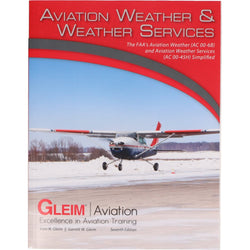For new student pilots, weather reports can be tricky to understand. They use terms that we don't often hear in our everyday lives. One of those terms is "cloud ceilings". This may seem like a strange phrase, but it's actually very important for new pilots to know if they want to be able to read weather reports (METARs) correctly.
In this article, we'll break down what cloud ceilings are and how cloud ceilings work to help you understand them better.
Let's get started!
 What Are Cloud Ceilings?
What Are Cloud Ceilings?
A cloud ceiling refers to the altitude of the lowest cloud layer that is covering more than half the sky. This is typically measured in relation to ground level. Simply put, it is the cloud base at which a blanket of cloud coverage forms. This information is commonly denoted as either "broken layer" (BNK) or "overcast" (OVC) on a weather forecast.
Cloud ceilings are reported as a height, for example, a report may state that the ceiling is 800 feet above ground level.
How Cloud Ceilings are Measured
-
Ceiling Balloons: These are special helium balloons sent up into the sky to measure how high clouds are.
-
Laser Ceilometers: A laser ceilometer shoots laser beams upwards, and when the light hits clouds, small components of light bounce back. By timing how long it takes for the light to return, they can calculate the height of the clouds.
-
Pilot Reports: Pilots who are flying share info about what they see from the sky. They report cloud types and heights, giving other pilots and weather experts real-time details about the sky conditions.
-
Optical Drum Ceilometers: These machines are stationed on the ground and use light to measure cloud heights above a particular location.
-
Weather-Observer: People trained to watch the sky estimate cloud heights by using their eyes and knowledge of different cloud types. This can be the least accurate estimate.
Known Terrain and Structure Heights
Another way for pilots to roughly gauge the height of clouds is visually seeing clouds hang around towers, or mountains with known/recorded heights.
Clouds around mountainous terrain can often signal danger if you want to fly VFR around the mountain range.
Even flying near the mountains without checking the forecast means that the winds could potentially cause limited visibility if the clouds are traveling toward your flight path.
 Cloud Ceilings vs Cloud Base
Cloud Ceilings vs Cloud Base
If you read the definition of a cloud base and a cloud ceiling, you might wonder if they're the same thing, since the explanation is so similar. But while cloud ceilings and bases might sound the same, they have key differences. The difference lies in their focus on the sky's lowest layer.
The sky can have multiple layers of clouds and the summation amount of the lowest layers range from 0/8 to 8/8.
-
Few (FEW 1/8 - 2/8 minimal coverage)
-
Scattered (SCT 3/8 - 4/8 some coverage)
-
Broken (BNK 5/8 - 7/8 almost full coverage)
-
Overcast (OVC 8/8 full coverage)
-
A cloud base refers to the lowest visible part of the clouds over the station.
-
A cloud ceiling refers to the distance between the ground or water and the base of the lowest layer of clouds, which must form a cloud cover that blankets more than half of the sky below 20,000 feet.
The measurement between the ground and the clouds matters, especially for VFR pilots, since it determines the highest altitude at which aircraft can safely maneuver without ending up in the clouds.
For instance, a low ceiling of 1,000 feet means that a persistent layer of clouds hovers at pattern altitude, creating obstacles for takeoff and landing, and impacting flight operations. This would make VFR flight impossible until the ceilings lift and conditions improve.
Understanding cloud ceilings is vital for pilots and meteorologists to navigate and accurately forecast weather conditions.
 Cloud Ceiling According to the METAR
Cloud Ceiling According to the METAR
Before planning a flight, pilots rely on METARs to determine the weather conditions. If they are planning on flying a VFR flight plan, they can check the current weather at their departure and destination airports.
If there is a low cloud ceiling or reported cloud base below VFR minimums, the pilot may need to alter their route to avoid potential IMC or marginal VFR conditions.
In some cases, the pilot may decide to cancel the flight altogether and reschedule for a day with more favorable weather conditions.
To gain the most up-to-date and accurate weather information, visit an official source such as aviationweather.gov.
 How to Read Cloud Coverage on a METAR
How to Read Cloud Coverage on a METAR
Let's check out this METAR for Houston:
-
KIAH 152333Z 27008KT 3SM RA BR FEW006 BKN013 OVC025 18/17 A3013 RMK AO2 P0002 T01780167
Let's decipher the reported cloud data:
Ceiling: 1300 feet AGL
Clouds: few clouds at 600 feet AGL, broken clouds at 1300 feet AGL, overcast cloud deck at 2500 feet AGL
 How to Read Cloud Coverage on a TAF
How to Read Cloud Coverage on a TAF
Let's check out this TAF for Houston:
-
KIAH 152353Z 33004KT 2SM +RA BR SCT006 BKN014 OVC025 17/17 A3014 RMK AO2 SLP205 P0017 60017 T01720167 10200 20172 53009 $
KIAH 152323Z 1600/1706 11008KT P6SM VCSH OVC015
FM160600 34006KT 4SM SHRA BR OVC007
FM161000 35007KT 6SM BR VCSH BKN009 BKN015
FM161200 34007KT P6SM BKN015
FM161400 34010G18KT P6SM FEW250
FM170000 34008KT P6SM SKC
Let's decipher the TAF:
Forecast period:0000 to 0600 UTC 16 December 2023
Ceiling: 1500 feet AGL
Clouds: overcast cloud deck at 1500 feet AGL
Forecast period:0600 to 1000 UTC 16 December 2023
Ceiling: 700 feet AGL
Clouds: overcast cloud deck at 700 feet AGL
Forecast period:1000 to 1200 UTC 16 December 2023
Ceiling: 1500 feet AGL
Clouds: broken clouds at 1500 feet AGL
Forecast period:1400 UTC 16 December 2023 to 0000 UTC 17 December 2023
Ceiling: at least 12,000 feet AGL
Clouds: few clouds at 25000 feet AGL
Forecast period:0000 to 0600 UTC 17 December 2023
Ceiling: at least 12,000 feet AGL
Clouds: clear skies
For more on METARS
If you're interested in learning more about METARS you can check out our guide on "How to Read METAR Aviation Reports"
 Takeaway
Takeaway
Being a safe pilot takes more than skill, it requires a passion for knowledge. As aviators, we understand that you can never be over-prepared for a flight.
Learning about the distance from the land to the ceiling of the clouds provides vital information for a pilot to be able to determine the path to take that will provide the most safety for a VFR flight, or if they're IFR rated, they might decide it's a good day to consider IFR flight planning before flying.
Keep your eyes on the skies and never stop being a student, thirsty for learning all aviation has to offer.
Fly safe!
Want to learn more about aviation weather?
Learn about everything from Visual Flight Rules to Instrument Flight. Our guides can help you brush up on aviation weather terms and detail the important facts you need to know about clouds.
-
12 Types of Clouds Pilots Must Recognize [#12 Can be Deadly]
-
7 Types of Turbulence Every Pilot Should Know (What Causes It)
Did you find this article helpful?
Do you think we missed anything important? Let us know in the comments below!









